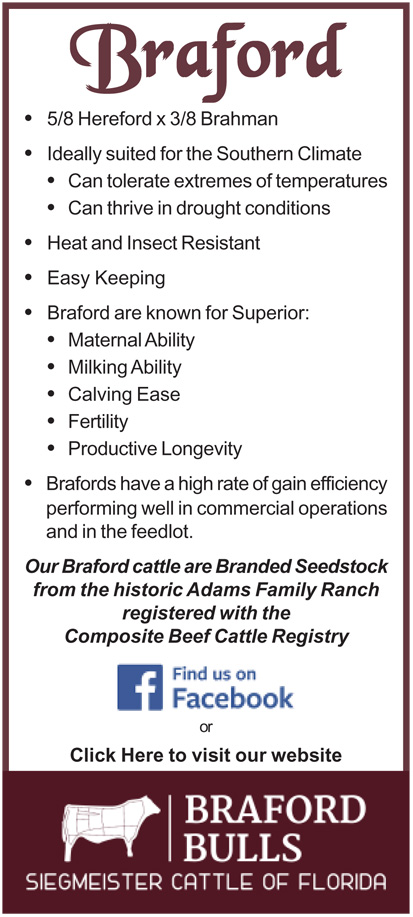Why Breed Composites
CompositeBeef Cattle
are a range of new breeds or new lines
bred specifically to improve hybrid vigor
Many of today's beef breeds that are considered purebreds are actually composites if you go back far enough. These breeds were developed through careful planning, selection and combining of desirable traits from two or more breeds into one "package".
The goal and purpose of combining breeds to create new composites is to retain heterosis (hybrid vigor) in future generations without crossbreeding and then maintain them as purebred. When a composite is created, this is usually done with exact percentages of each breed and can vary depending on the goals and objectives.
Breeding Composites - involves mating individuals
from different breeds or lines utilizing the best bulls from breeds
that are better suited to your farm conditions.
Breeding Composites is being practiced by more and more beef producers. Producers are realizing that to stay viable,they must look at ways that can add to their bottom line profits. A well planned breeding program is a long term investment that can be utilized with proper management.
One of the key factors affecting successful breeding of Composite beef cattle is the knowledge of available breeds, their strengths and weaknesses and how to utilize them in a breeding program within the herd.
Opportunities with Composite Beef Cattle
The beef industry has encountered many changes and challenges over the years. There was a time that for the most part, the US beef herd consisted of straight-bred or purebred Angus (red or black), Hereford (polled or horned), Shorthorn, Red Poll, British White and Galloway.
The major characteristics that are important in beef production are mature body size, milk production, age at puberty, environment adaptability, rate and efficiency of gain, muscle expression, cutability and marbling.
Producers need to breed animals that have a balance of carcass traits. British breeds, also known as English breeds, originated in the British Isles. Characteristics of these British breeds is they tend to be smaller in size that Continental breeds but have an increased fleshing and marbling ability. It is these British breeds that are the foundation of the US beef herd. Continental breeds which originated in Europe and are known for their weight gain and cutability and have generally been larger in size, leaner and more muscular.
Crossbreeding programs need to use breeds that possess complimentary characteristics to produce desirable offspring. For best results, a crossbreeding system can produce an animal that will yield carcasses that can meet many value-based markets by breeding cattle that have from 25% British and 75% Continental to 75% English and 25% Continental. This is why using Composites can simplify a crossbreeding program yet retain and increase not only hybrid-vigor but also carcass quality.
While the important factors for the cow-calf producer are milk production, weaning weight and age at puberty, the stocker and feeder owners are more concerned with efficiency of gain, rate of gain and carcass traits. The two factors that contribute to both situations is mature body size and milk production.
Benefits of composite beef cattle to seedstock and commercial producers is they allow focused breeding with adequate reliability and animals than can that fit a producers environment and production goals.
| Mating Type | Heterozygosity % reletive to F1 |
Estimated increase in weight weaned per cow exposed (%)a* |
|---|---|---|
Purebred |
0 | 0 |
2 - breed rotation |
66.7 | 15.5 |
3 - breed rotation |
85.7 | 20 |
4 - breed rotation |
93.3 | 21.7 | 2 - breed Composite | % | % |
F3 - 1/2A, 1/2B |
50.0 | 11.6 |
| F3 - 5/8A, 3/8B |
46.9 | 10.9 |
| F3 - 3/4A, 1/4B |
37.5 | 8.7 | 3 - breed Composite | % | % |
| F3 - 1/2A, 1/4B, 1/4C |
62.5 | 14.6 |
| F3 - 3/8A, 3/8B, 1/4C |
65.6 | 15.3 |
| 4 - breed Composites | % | % |
| F3 - 1/4A, 1/4B, 1/4C, 1/4D |
75.0 | 17.5 |
| F3 - 3/8A, 3/8B, 1/8C, 1/8D |
68.8 | 16.0 |
| F3 - 1/2A, 1/4B, 1/8C, 1/8D |
65.6 | 15.3 |
| 5 - breed Composites | % | % |
| F3 - 1/4A, 1/4B, 1/4C, 1/8D, 1/8E |
78.1 | 18.2 |
| F3 - 1/2A, 1/8B, 1/8C, 1/8D, 1/8E |
68.8 | 16.0 |
| 6 - breed Composites | % | % |
| F3 - 1/4A, 1/4B, 1/8C, 1/8D, 1/8E, 1/8F |
81.3 | 18.9 |
| 7 - breed Composites | % | % |
| F3 - 3/16A, 3/16B, 1/8C, 1/8D, 1/8E, 1/8F, 1/8G |
85.2 | 19.8 |
| 8 - breed Composites | % | % |
F3 - 1/8A, 1/8B, 1/8C, 1/8D, 1/8E, 1/8F, 1/8G, 1/8H |
87.5 | 20.4 |
a* - Based on heterosis effects of 8.5% for individual traits and 14.8% for maternal traits and assumes that retention of heterosis is proportional to retention of heterozygosity. Gregory, K.E., et al. (1990) |
||




